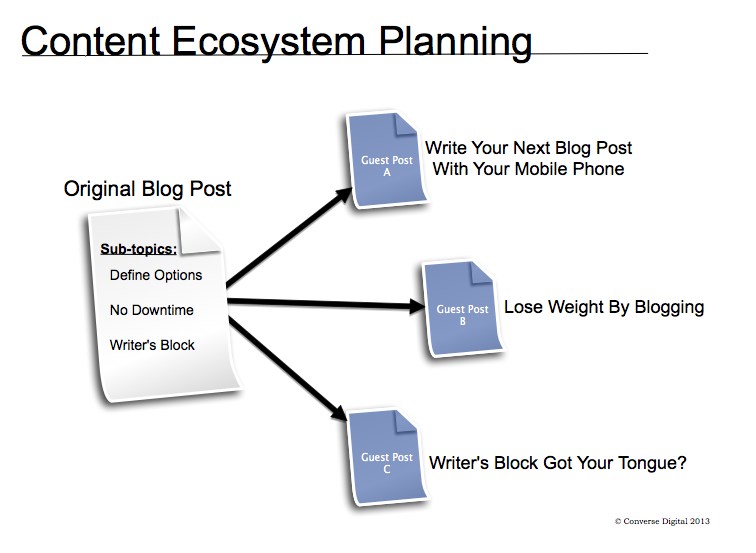Let me show you an example of how this might work, using Chapter 14, of my book, The Invisible Sale, “Creating Text-Based Content.” Chapter 14 easily deconstructs into multiple individual blog posts. One blog post idea is to repurpose the “Talking vs Typing” section into a blog post titled “How to Use Voice-to-Text Transcription Software to Create More Blog Content.” The post could summarize a few key points from Chapter 14 without going too deep into any one of the points. For instance, the post can include the following subheads/sections:
- Defining voice-to-text software options
- Using mobile voice-to-text apps to turn downtime into writing time
- Using voice-to-text software to overcome writer’s block
This is a simple, helpful blog post. Most content creators would stop there—but that’s a mistake. By focusing on the mobile angle, I can repurpose this post into three distinct but similar guest posts for publication on my Outposts – platforms where I have publishing rights and my prospects look to for content creation insight to help Google Proof my content marketing efforts.
The figure below shows how I can repurpose this post by simply expanding on the mobile voice-to-text application theme and show how a blog content creator can utilize a mobile app to create more blog content.

Guest Post #1
I create a guest post that defines the mobile voice-to-text option, describes the mobile app, and then explains how the blogger uses the mobile app to write a blog post. Notice that all this information is in my original post—I’m just reorganizing it and presenting it through a different lens. Whereas the original post discussed all voice-to-text options, for this guest post, I limit the discussion to the mobile app.
Guest Post #2
Then I reframe the content for Guest Post B. Instead of just explaining how to write a blog post with audio-to-text apps, I present that capability in the context of multitasking. Specifically, I can write Guest Post B to solve two common complaints business content creators voice: lack of time to write and exercise. This post contains a lot of the same information, but it’s presented through an exercising lens and in a less serious tone. In fact you can read the actual real-world post over at MarketingProfs.
Guest Post #3
Finally, I present the same information again, but as a solution to another common business content creators’ challenge: writer’s block. This post focuses on the idea of breaking through writer’s block by using the voice-to-text mobile app and just recording stream-of-consciousness thoughts. The core information in the post is similar to the content in Guest Post A and Guest Post B, but again, I change the lens to create a different post.
The Art of Guest Posting
If I created these three posts on my own blog, my readers would figure out that I’m just repurposing the same post through three different angles and would likely abandon my blog. But because these three posts appear on three different media outlets, my prospects are less likely to make the connection. Even if they do, they won’t penalize me for repurposing content—they’ll understand that I’m writing content for various audiences, and that makes it okay to produce similar posts for different platforms. And because none of the content is truly duplicate (in Google’s eyes) there is absolutely no penalty for taking this approach.
This point is really important: Your ability to create propinquity and brand awareness is powered by publishing content on closed networks that have their own readership. It is an absolute must if you are going to be successful. Guest posting is simply advertising in different clothes. You’re buying access to eyeballs, just like you do with advertising. But there are three key differences.
First, you pay for your access with content instead of money.
Second, your prospects invite your message into their world; you don’t interrupt them with it.
Third, your content educates rather than sells. And while your prospects will willingly invite greater amounts of your helpful content into their world, you need them to do this because your selling message is softer and might take longer to create the sale.
Thus, the only way to economically produce the necessary volume of content to accomplish your selling goals is to follow the process that I outlined for you here. You have to think in terms of an ecosystem.
With a little thought, planning, and imagination, you can easily turn a single blog post into multiple guest posts, a podcast, and even a video tutorial. But if you don’t plan to do it, it won’t happen.
Need some help planning your company’s content marketing? We’d love to help you. Just drop us a line below.
[gravityform id=”4″ title=”false” description=”false”]

